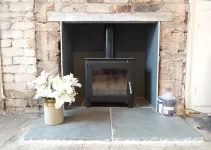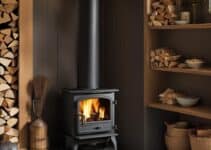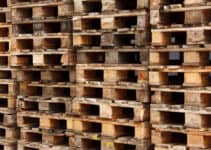In the pursuit of maintaining a cosy and warm home, especially during the colder months, many turn to their trusty log burners for comfort. However, a crucial element of ensuring the efficiency and safety of your log burner experience lies in the choice of fuel. As an informed homeowner, I often come across the query: ‘Can I burn treated wood in my log burner?’ The answer is pivotal, not only for the safety of my family but for the environment as well.
Burning treated wood in a log burner poses significant dangers. Treated timber, often laced with chemicals to fend off rot and insects, becomes a concoction of harmful toxins when alight. These emissions threaten the health of my loved ones – children and elderly alike – and contribute to environmental degradation. Moreover, the safety of burning treated wood in a log burner comes into question considering how it can result in damaging the appliance itself.
The risks associated with selecting the wrong materials to burn are too great to ignore. Thus, in my endeavours to keep my home’s air clean and my family safe, I strictly adhere to the guidelines around responsibly fuelling my log burner. Join me as I delve deeper into this topic to safeguard our homes and our planet.
Understanding the Risks of Burning Treated Wood
The implications of using treated lumber in residential stoves are a topic of crucial importance for homeowners who value the safety and air quality of their living spaces. Not only does the combustion process release harmful pollutants into the environment, but there are also personal health ramifications that need to be seriously considered. In this section, we delve into the consequences of burning treated wood in log burners and the broader environmental and health impacts of such practices.
The Toxic Fumes from Treated Wood
When treated wood is exposed to the high temperatures in a log burner, it produces a plethora of toxic fumes. One of the most notorious chemicals released is arsenic, a byproduct of chromated copper arsenate (CCA)-treated wood. The presence of arsenic in the air is profoundly unsettling, as it can compromise the indoor air quality of one’s home and have severe long-term health implications.
How Burning Treated Wood Affects Your Health
My investigation into the health ramifications of burning treated lumber in residential stoves reveals a grim picture. Not only do the toxic chemicals contribute to acute respiratory distress, but the chronic exposure could also escalate the risk for serious illnesses, including cancer. Pressure-treated lumber, often deemed a durable building material, conceals insecticides and fungicides within its fibres, which become airborne and increasingly dangerous when incinerated.
Environmental Concerns with Treated Wood Emissions
The environmental impact of burning treated wood is not to be underestimated. The pollutants unleashed not only mar the purity of our air but also contribute to broader ecological imbalances. The toxic constituents of treated wood don’t just evaporate—they linger, insidiously affecting plant and animal life, and contributing to the degradation of our cherished natural resources.
Through my analysis, it’s become clear that the allure of pressure-treated wood’s resistance to decay and insects is overshadowed by the peril it poses through combustion. Although the Environmental Protection Agency (EPA) has restricted the use of CCA-treated wood, older installations still lurking in homes raise concerns for inadvertent burning. Therefore, understanding these risks is essential for safeguarding both personal health and the environment from the consequences of burning treated wood in log burners.
Can I Burn Treated Wood in My Log Burner?
When it comes to heating one’s home with a log burner, especially during the colder months, the question arises: can you burn treated wood in a log burner? The straightforward answer is a resounding no. This categorical conclusion stems from the fact that burning pressure treated wood in a log burner can release harmful chemicals, thus making it an unsafe practice for both the individual and the environment. As a professional in the journalism field, I have delved into why pressure-treated timber, though excellent for outdoor use, has no place within your log burner.
Pressure-treated wood undergoes a chemical process that enables it to resist decay and insect damage effectively. However, these very chemicals that impart resilience to the wood, are hazardous when combusted and inhaled. Not only are organisations like the Consumer Product Safety Commission (CPSC) and the Environmental Protection Agency (EPA) aligned on this issue, but safety and home improvement professionals agree – burning such materials is dangerous and can lead to severe corrosion of stoves and release of toxins.
“Burning treated lumber not only undermines the air quality but also poses significant health risks. As a safety measure, it’s imperative that one avoids using treated wood as fuel.”
So, dismissing the idea that one can responsibly dispose of pressure-treated wood by burning, let’s look at safer alternatives to dispose of such wood responsibly.
- Consult your local waste management department for guidance on disposing of treated timber.
- Some communities set aside specific disposal days for hazardous waste — take advantage of these if available.
- Always remember, untreated wood remains the optimal fuel for your log burner.
Being aware and choosing the correct method of disposal directly impacts not only our health but also the well-being of our environment. Let’s make decisions that favour both.
Recognising the Different Types of Treated Wood
As a responsible homeowner, I’ve learned that understanding how to identify and properly manage treated wood is crucial. This is especially important because improper handling or burning such wood in log burners can pose serious health and environmental risks. Here, I’ll outline how to identify pressure-treated lumber and provide safety tips for its management, aligning with the utmost precautions necessary for burning treated wood in log burners.
Identifying Pressure-Treated Lumber
Identification of pressure treated wood types often begins with a visual inspection. Chromated copper arsenate (CCA)-treated wood, for instance, is typically characterised by a greenish hue. However, not all pressure-treated wood can be identified by colour alone, and in such cases, a professional chemical analysis may be required. Do note that newer varieties of treated wood may utilise alternative preservatives, which can make visual identification even more challenging.
I’ve compiled a table to assist you in distinguishing between common types of pressure-treated wood, which can help prevent the accidental burning of these materials in your log burner:
| Type of Treatment | Common Uses | Identification Markings | Visual Characteristics |
|---|---|---|---|
| CCA (Chromated Copper Arsenate) | Outdoor structures, decking | End tag with ‘CCA’ | Greenish tint |
| ACQ (Alkaline Copper Quaternary) | Landscaping timber, playsets | End tag with ‘ACQ’ | Less prominent green hue, sometimes brownish |
| CA-B (Copper Azole Type B) | Decking, fencing | End tag with ‘CA-B’ | Light brown to greenish-brown |
Safety Measures When Handling Treated Wood
Whenever I handle pressure-treated wood, I make sure to wear protective gloves and a mask to prevent any contact with the skin or inhalation of sawdust. It’s vital not to burn pressure-treated wood under any circumstances, due to the release of toxic chemicals. Instead, such wood should be disposed of in accordance with local regulations, typically at a designated waste management facility.
- Always wear protective gear when handling treated wood.
- Burn only wood confirmed to be untreated.
- Dispose of treated wood properly, avoiding incineration.
- Consult with local waste management facilities for the appropriate disposal method.
Taking these precautions helps in maintaining the safety of your home’s indoor air quality, as well as protecting the environment.
Consequences of Burning Treated Wood in Your Log Burner
As a conscientious homeowner, it’s imperative to understand the profound health hazards of burning treated wood. The act of igniting such materials in a domestic log burner can lead to a cascade of hazardous chemicals being released into the environment, posing significant risks to the health and safety of the household.
Amongst the most dangerous emissions are arsenic and copper – heavy metals that can have immediate and long-term detrimental consequences for human health. Acute exposure to these chemicals presents risks such as skin irritations and gastrointestinal discomfort. When exposure is prolonged, the spectrum of possible health effects broadens alarmingly, including an increased risk of chronic respiratory diseases and even cancer.
Moreover, the damaging effects of burning treated lumber extend beyond just health concerns. The high temperatures associated with combustion of these timbers can result in accelerated damage to the very infrastructure of your log burner. Corrosive gases released can quickly wear down the internal components, reducing the lifespan and efficiency of the heating system – a costly consequence that’s best avoided.
- The complex chemical makeup of treated wood is not suited for combustion in residential environments.
- Burning treated wood contributes to air pollution and the release of carcinogenic substances.
- Homeowners must dispose of treated lumber through authorised waste management services to mitigate risks.
It’s my task, as an informed writer and advisor, to steer you away from the enticing yet harmful practice of burning leftover construction materials. Not only for the sake of your health and property but also in consideration of preserving the environment. Let’s commit to responsible practices that ensure our enjoyment of life’s simple pleasures, like a warm hearth, does not come at an exorbitant price to our well-being or our planet’s health.
Alternatives to Burning Treated Wood in Your Log Burner
As an advocate for sustainable living and with a professional stance on home heating, I implore homeowners to consider eco-friendlier and healthier options than burning treated wood in log burners. Let’s explore how alternatives like kiln-dried and seasoned wood can enhance your heating experience while keeping your home safe and your air clean.
Selecting the Right Wood for Your Burner
My experience whispers a simple truth: not all woods are equal for your log burner. Kiln-dried wood, the champion of efficiency, stands out for its low moisture content, which translates to higher combustion efficiency and less smoke. This means a heartier fire and clearer air. If I may point towards another stellar option, seasoned wood also provides excellent fuel. Curing for an extended period, seasoned wood’s moisture content decreases naturally, ensuring a clean burn that will add warmth to your home without the harmful effects of treated wood.
Benefits of Kiln-Dried and Seasoned Wood
When I consider the advantages of kiln-dried wood, terms like ‘energy-efficient’ and ‘clean burning’ spring to mind. This wood type burns at a high temperature, efficiently converting wood to heat. Here’s a clear benefit: it reduces tar build-up in your stove’s flue, prolonging its life and optimizing performance. Moreover, seasoned wood, having basked in time to shed moisture, offers a burn that’s both consistent and manageable. Both options are far better alternatives to burning treated wood in your log burner, as they do not release the toxic chemicals associated with treated lumber.
In all candour, sourcing wood with the Woodsure Ready to Burn certification marks an informed choice, securing not just the dryness of the timber but also the assurance it’s from a renewable source, aiding in the staving off of deforestation. The next time you stock up on wood, remember: choosing kiln-dried or seasoned logs isn’t just a personal boon; it’s a commitment to the environment.
Conclusion
In summary, the act of burning treated wood within your log burner emerges as a resounding misstep, one rife with dire consequences for both personal wellbeing and the integrity of our precious environment. My findings underscore that not a single instance warrants this hazardous practice. I’ve unearthed an array of risks associated with these materials, which fervently advocate for precautions for burning treated wood in log burners.
The pathway forward, which aligns firmly with the responsible use of log burners, hinges on selecting the appropriate untreated wood alternatives. Engaging with this informed approach not only champions efficiency but also upholds ecological balance, creating a sanctuary of warmth in your home that does not come at the expense of our health or that of the Earth. The embrace of kiln-dried or seasoned wood exemplifies this ideology, representing a harmonious blend of indulgence and accountability.
As we march towards colder days, let us kindle our fires with mindfulness, understanding the gravity our choices bear on the delicate tapestry of life. Embodying the spirit of responsibility, I endorse and commend a steadfast commitment to sustainable practices, assuring that the warmth we seek today remains a comfort that can be cherished by generations yet to come.



